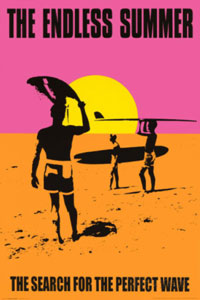|
The emails went out early as another “super storm” threatened to bring civilization to the edge of collapse: “because of forecasts predicting severe winter weather, classes tomorrow will be cancelled throughout the Princeton School District.”
Minnesotans have a name for this kind of precipitation, they call it “Tuesday.” But I’ll take a snow day anywhere I can get one.
“We’re in luck, kid,” I said to my daughter, “no school tomorrow.”
Ah, knowledge in which to luxuriate. Now we could stay up a little later than usual, watch a flick, and sleep in. Before I could suggest a title, my daughter asked: “Daddy, can we watch that movie about the two guys who go surfing all around the world?”
“You mean The Endless Summer? What a perfect choice!”
Inspired, really. Snowflakes the size of quarters falling everywhere; the preternatural brightness of all that white despite evening’s onset; the stark outlines of barren trees like austere Japanese charcoal sketches; and we’re going to bask in 95 minutes of cinematic sunshine.
If you’re not familiar with this legendary surfing documentary I suggest you remedy the gap in your connoisseurship because you’re missing out. (Even if you haven’t watched the film, I bet you’ve seen its promotional poster designed by John Van Hamersveld, an image deserving of the term “iconic.”)
 Like many pioneering films, The Endless Summer was a labor of love and a long shot. Bruce Brown, a lifelong California surfer, started making home movies of his fellow sportsmen in 1958. And like many innovative artists, he had some proselytizing to do. Brown set out to not only showcase the beauty of catching a wave, but also dispel the surfer stereotype that already obtained by 1963. Like many pioneering films, The Endless Summer was a labor of love and a long shot. Bruce Brown, a lifelong California surfer, started making home movies of his fellow sportsmen in 1958. And like many innovative artists, he had some proselytizing to do. Brown set out to not only showcase the beauty of catching a wave, but also dispel the surfer stereotype that already obtained by 1963.
He wanted to present surfing and surfers as they really were.
What Brown achieved exceeded his goals in every way, in large part due to his movie’s premise, a poetic fancy–which Brown articulates as narrator–as tantalizing as the notion of immortality: “With enough time and enough money, you could spend the rest of your life following the summer around the world.”
And that’s what Brown and his two surfing protagonists, Mike Hynson and Robert August, do. Theirs is a quest, as the slogan on the movie poster states: the search for the perfect wave. But it’s also a metaphysical journey for a kind of spiritual attainment; they seek to never leave that warm, wonderful state of mind called “summer.”
Mike and Robert journey from their native southern California to Senegal, Ghana, Nigeria, South Africa, Australia, Tahiti, New Zealand, and Hawaii. (Departing LAX decked out in natty blue blazers and loafers, Mike and Robert look more like they’re heading off to an Ivy League college than a surfer’s odyssey.)
At each far-flung destination they make friends with the locals, ambassadors on behalf of an ancient Polynesian sport. At some of the spots they surf, neither the waves nor the seaside residents had ever seen a longboard and its acrobatic occupant. The curiosity and sheer joy which Mike and Robert bring to one African fishing community will warm your heart.
Warmth pervades The Endless Summer and not just because of the balmy climes of its itinerary. You hear it in Bruce Brown’s good-natured narration as well as in the pleasantly drowsy soundtrack by the Surf-Rock band The Sandals (“Theme to the Endless Summer” is the musical equivalent of a hammock nap in the shade of a palm with trade winds gently blowing.) And you feel the warmth in the voluptuous textures of that film stock, originally shot on Brown’s 16-millimeter Bolex camera.
The movie immediately takes you in and welcomes you, whether you grew up in flip-flops across the PCH from Huntington Beach or you’re a Nebraska cornhusker who once saw the sunset on Lake Michigan. It’s not a documentary of the kind they make nowadays of “extreme” surfing, the viewer forced to endure blaring Death Metal while tacitly humbled, an outsider given the privilege of spying on the elites.
Though Brown finished the film in 1964, he had a difficult time finding a distributor who believed in it as much as he did. He took it on the road, showing it to audiences in school auditoriums and the reaction was positive. He even rented a cinema in February of 1966 in Wichita, Kansas–the aptly named Sunset Theater–and packed ‘em in for two weeks (can you imagine watching The Endless Summer on a big screen in Wichita in February?)
Then, in June, he went for it. He borrowed $50,000 to have the movie transferred from 16 to 35 millimeter film. He rented the Kips Bay Theater on Manhattan’s East Side. And, very quickly, he found a promoter. Released to international audiences in 1966, The Endless Summer grossed $30 million and became a beloved masterpiece. (Bruce Brown died in December 2017 at the age of 80.)
Around eight o’clock the next night, the phone rang with a pre-recorded message: “due to extensive damage caused by the storm to infrastructure, power lines, roads, and the very foundations of life as we know it, classes tomorrow will be cancelled throughout the Princeton School District.”
With water running at the tap, light pouring out of bulbs around the house, heat cranking from baseboard radiators, and uninterrupted access to 900 cable channels, the “important message” I’d just received meant only one thing: cinematic Gemütlichkeit in excelsis.
Translation: Movie Night Part II.
Me and the kid had watchedThe Endless Summer once before, so this evening I decided on a classic neither of us had seen: Willy Wonka & the Chocolate Factory–the original from 1971, of course, with the great Gene Wilder in the title role.
Musicals of any sort were anathema to me when I was a boy; I wanted to watch Patton, The Great Escape, or The Dirty Dozen. Heck, I’d even settle for Kelly’s Heroes. Decades later, though, with a taste for poetry, I took a liking to a song from this film, the beautiful ballad sung by Willy Wonka himself, “Pure Imagination.”
 You see, it’s the poem Wallace Stevens might have written in high school . . . or in his last years. It’s so Stevensian that sometimes when I hear the song I crack up imagining a different musical: our exquisitely cultured lawyer stands up in the well-appointed boardroom of the Hartford Accident and Indemnity Company and belts out to his utterly incredulous secretary and colleagues the following words: You see, it’s the poem Wallace Stevens might have written in high school . . . or in his last years. It’s so Stevensian that sometimes when I hear the song I crack up imagining a different musical: our exquisitely cultured lawyer stands up in the well-appointed boardroom of the Hartford Accident and Indemnity Company and belts out to his utterly incredulous secretary and colleagues the following words:
Come with me and you’ll be
In a world of pure imagination.
Take a look and you’ll see
Into your imagination.
We’ll begin with a spin
Traveling in the world of my creation,
What we’ll see will defy explanation.
If you want to view paradise
Simply look around and view it,
Anything you want to, do it.
Want to change the world?
There’s nothing to it.
There is no life I know
To compare with pure imagination.
Living there you’ll be free
If you truly wish
To be.
If that improbable scenario rings a bell it’s because something very similar actually happens in Mary Poppins (another movie I now adore but wouldn’t have watched as a kid for all the tuppence in the Fidelity Fiduciary Bank.) I know one thing: old Wallace would have delighted in Willy Wonka & the Chocolate Factory just as much as we did.
|